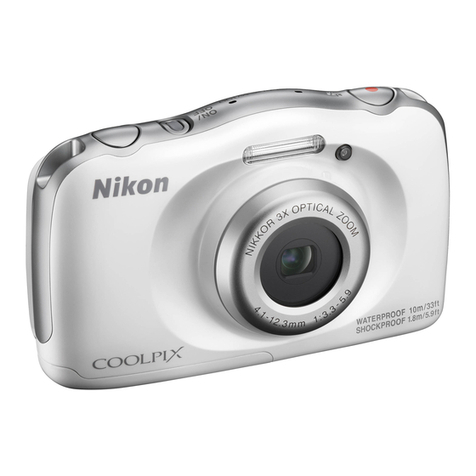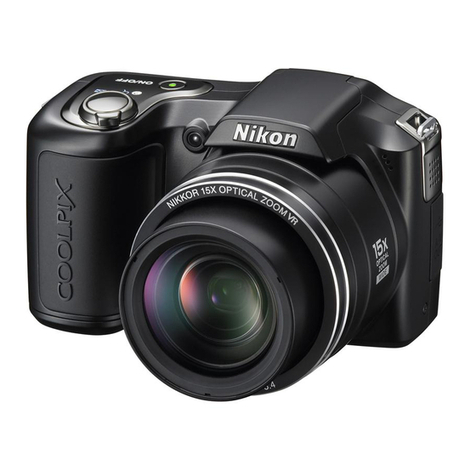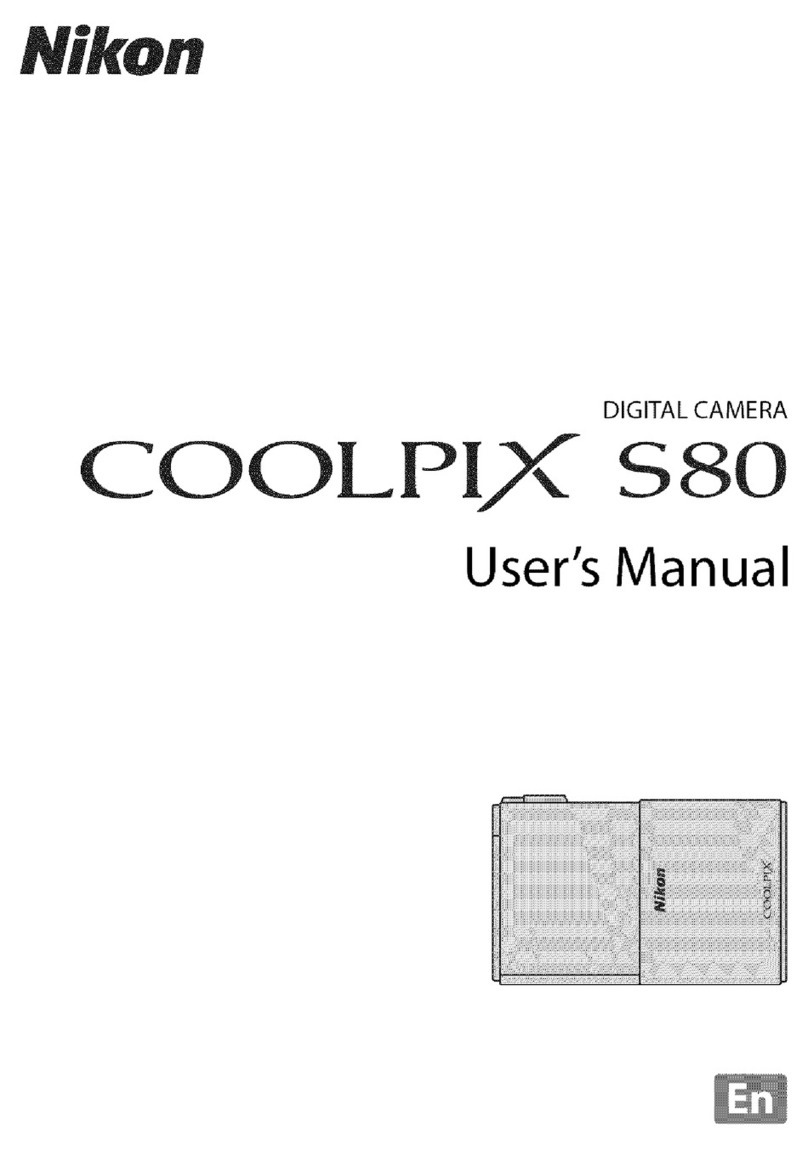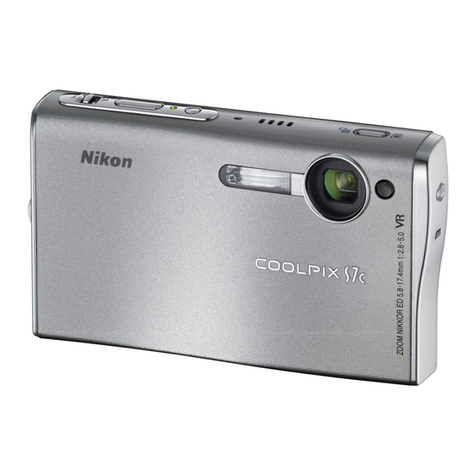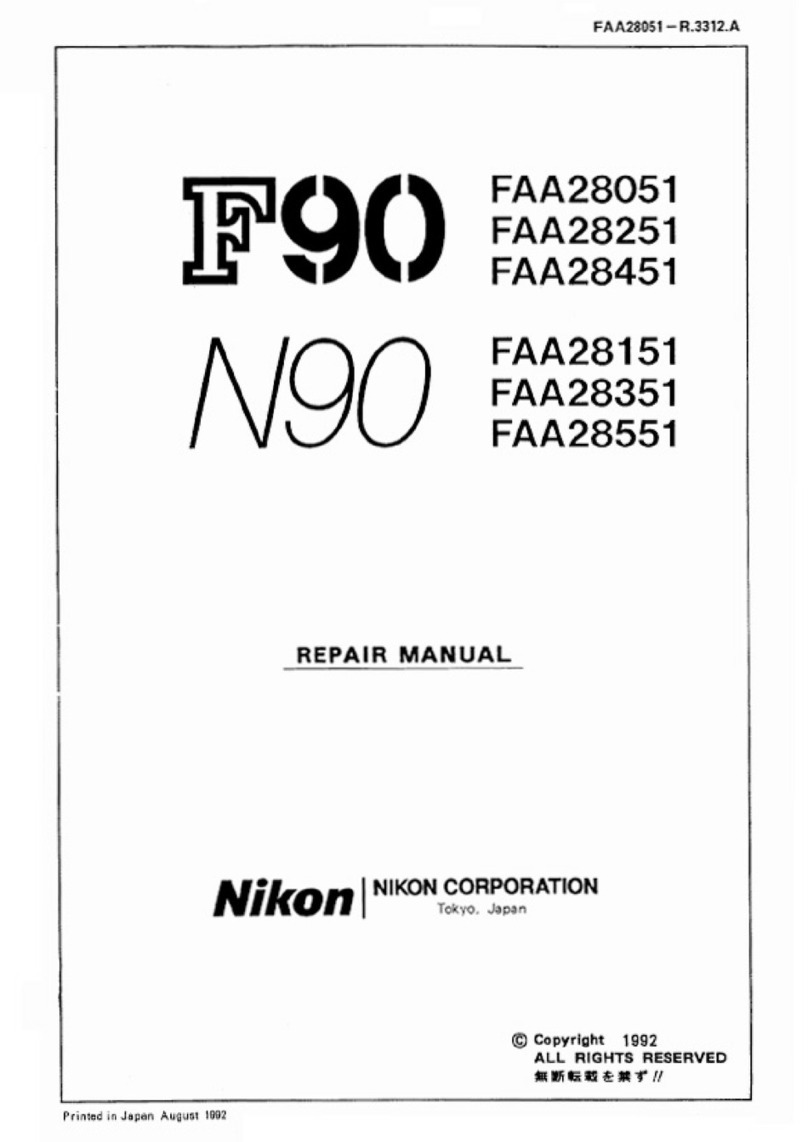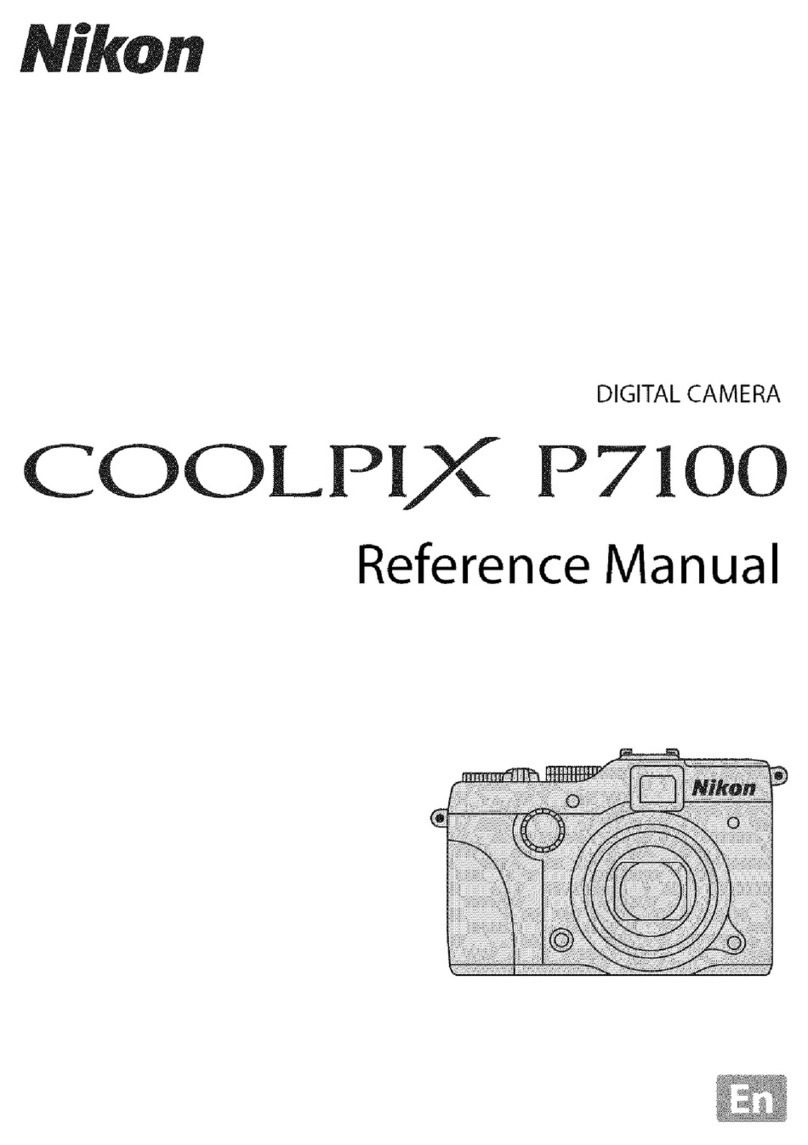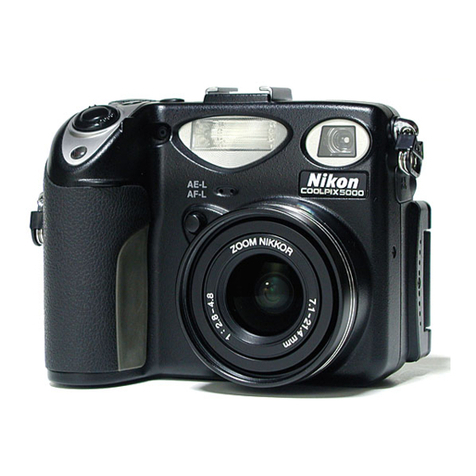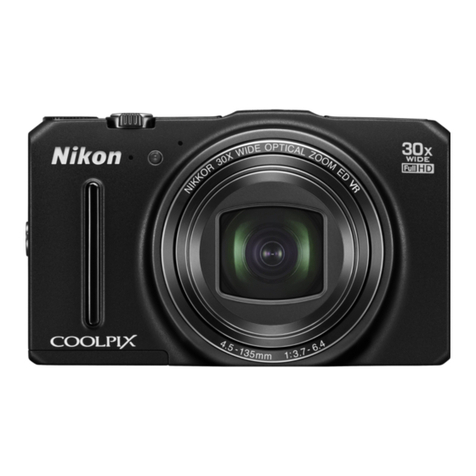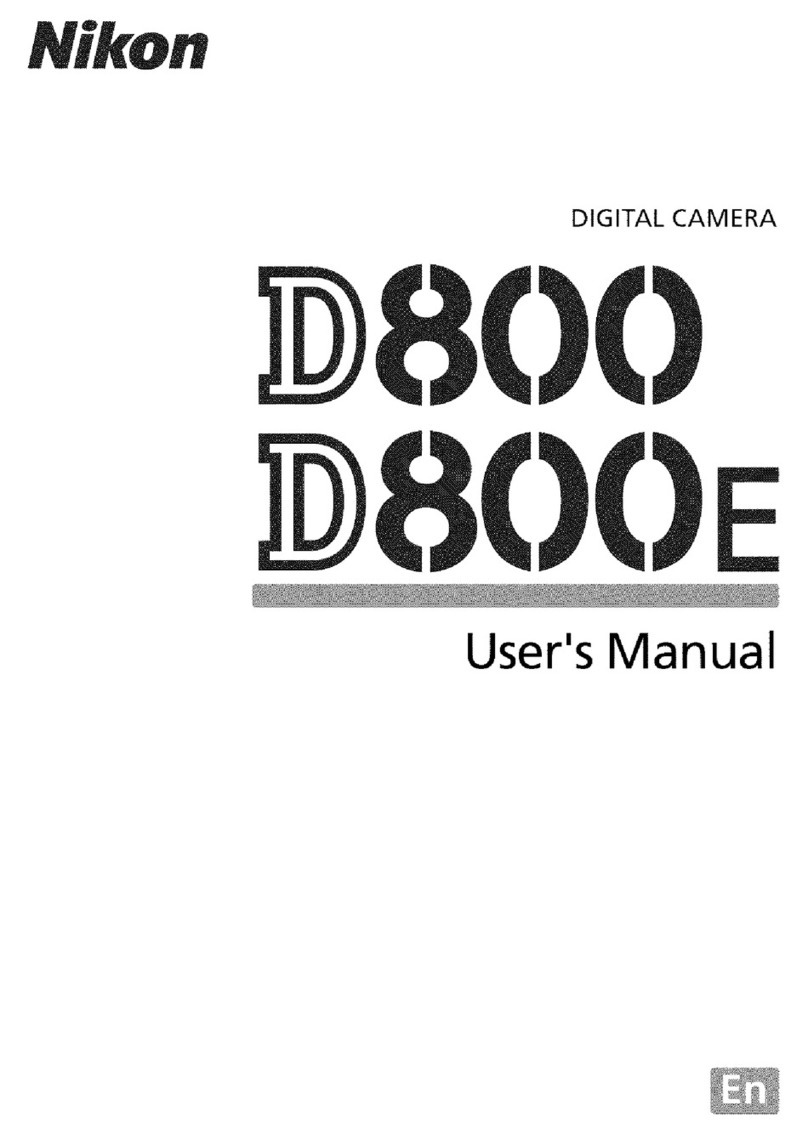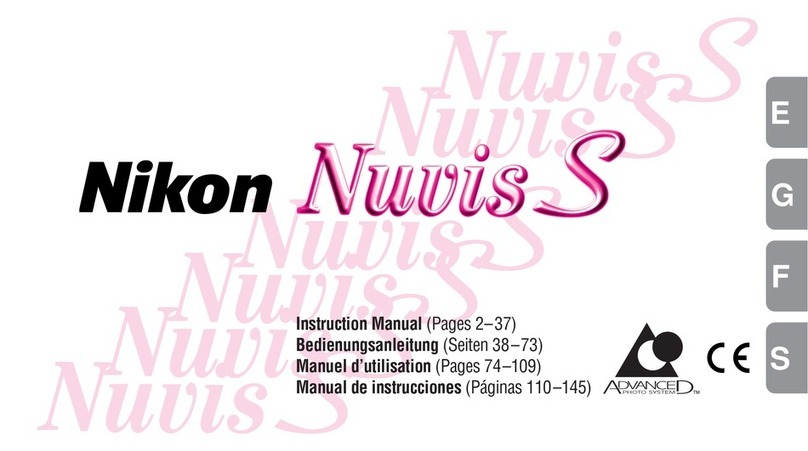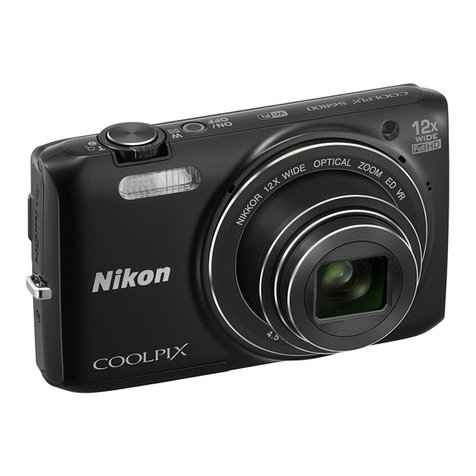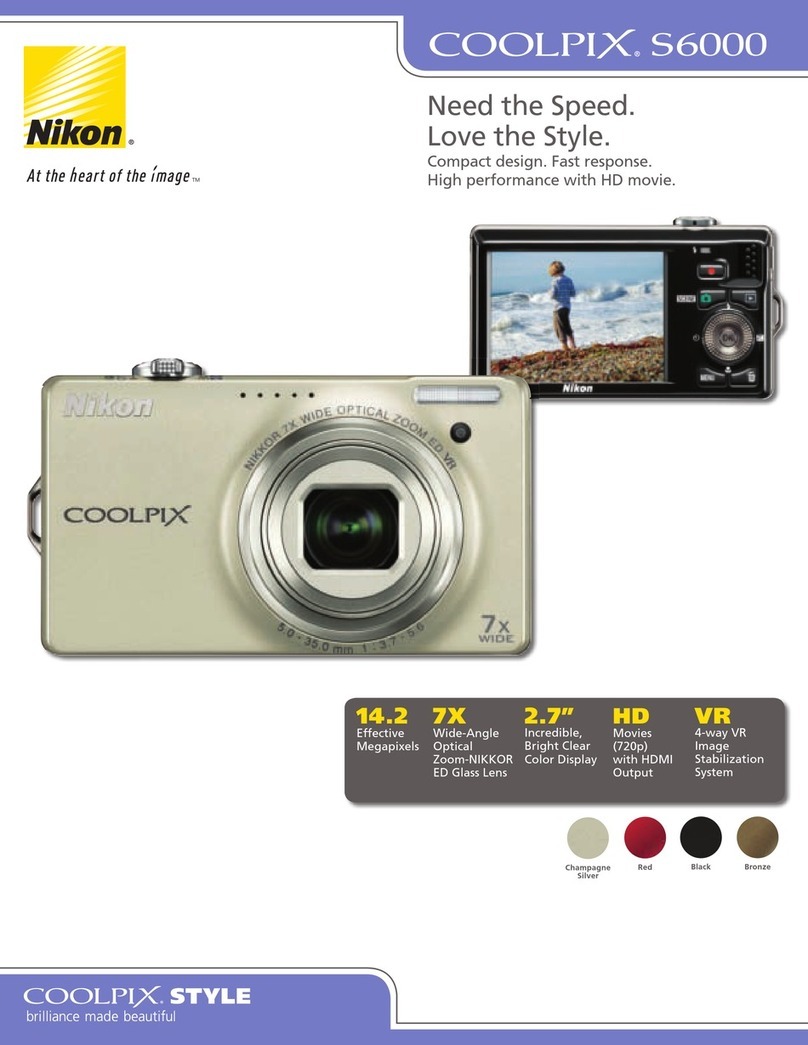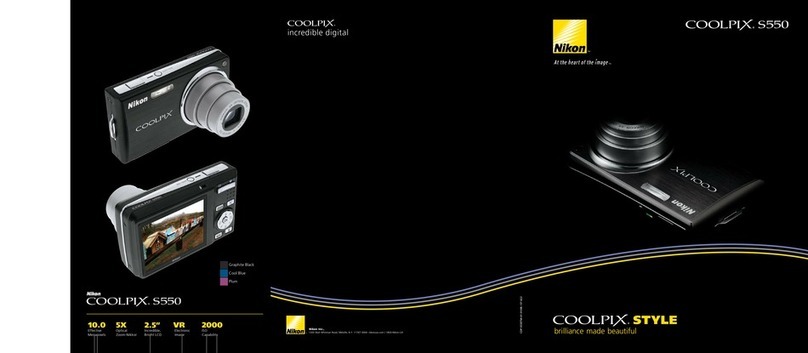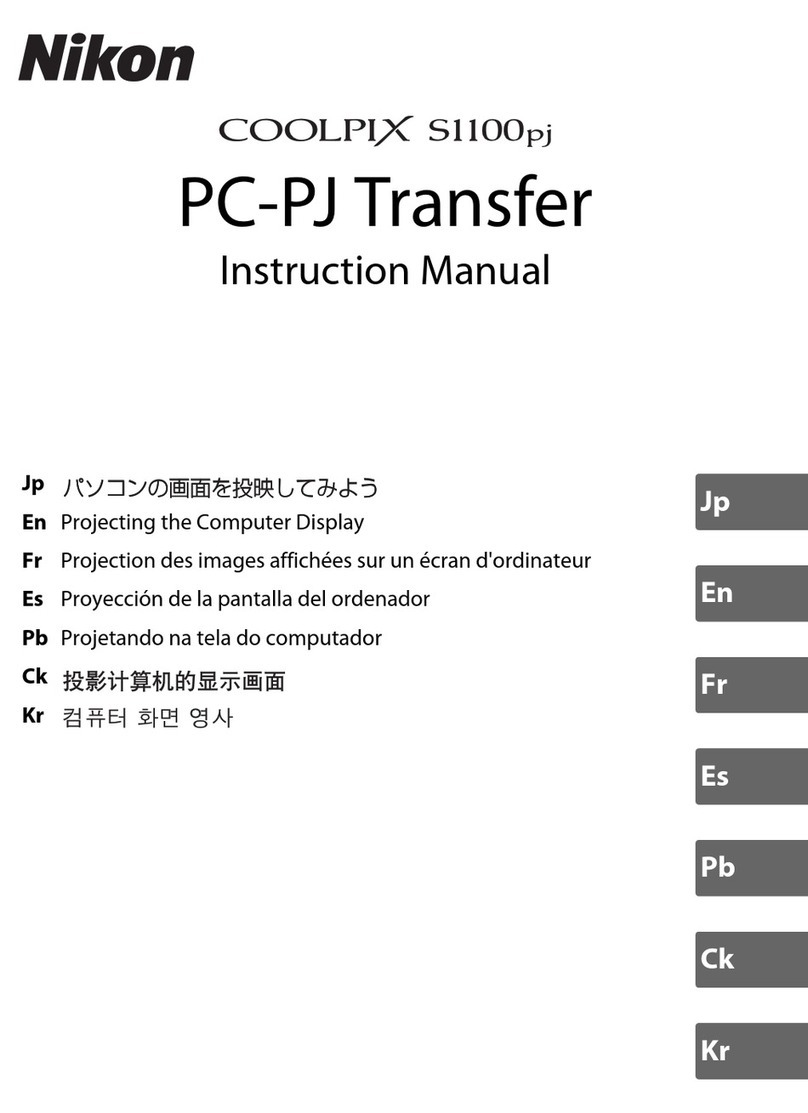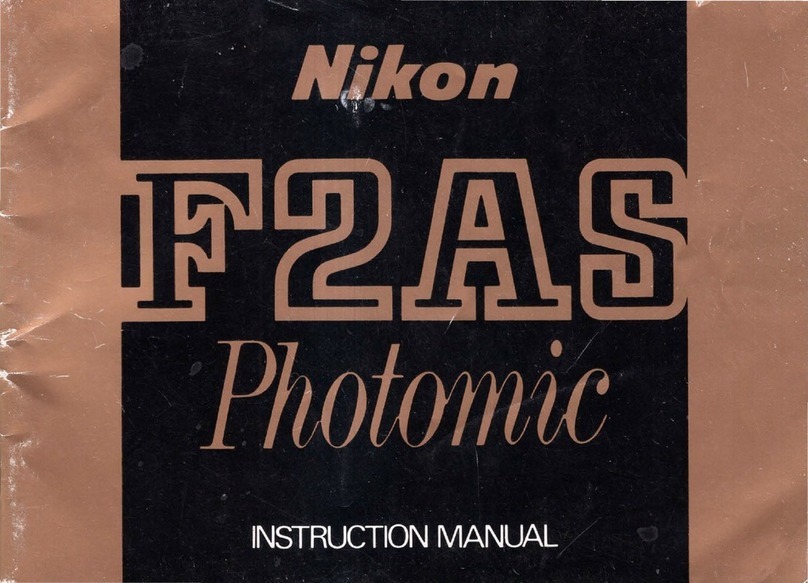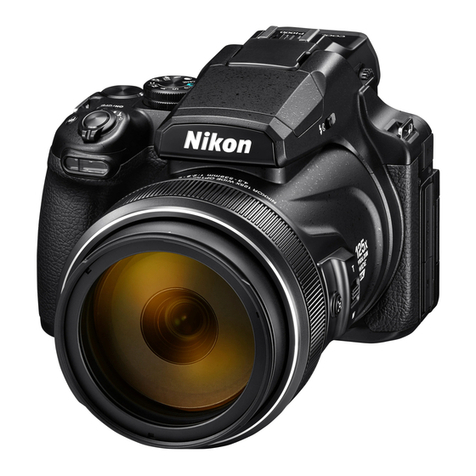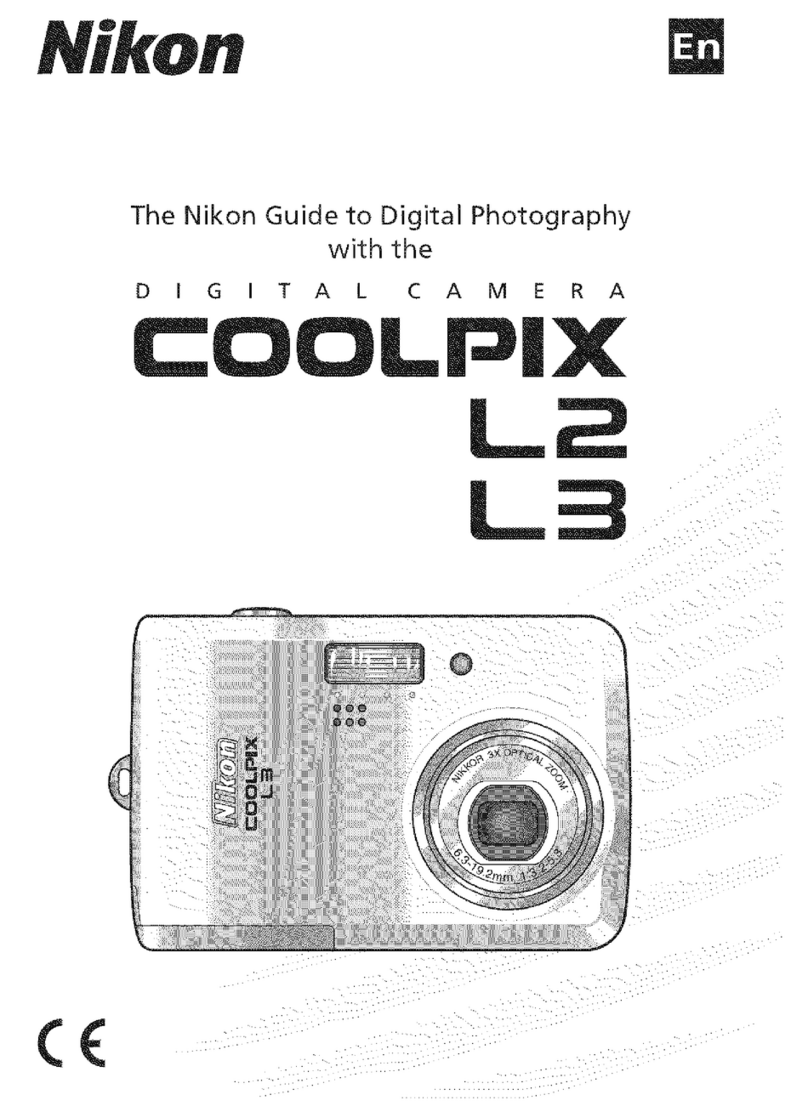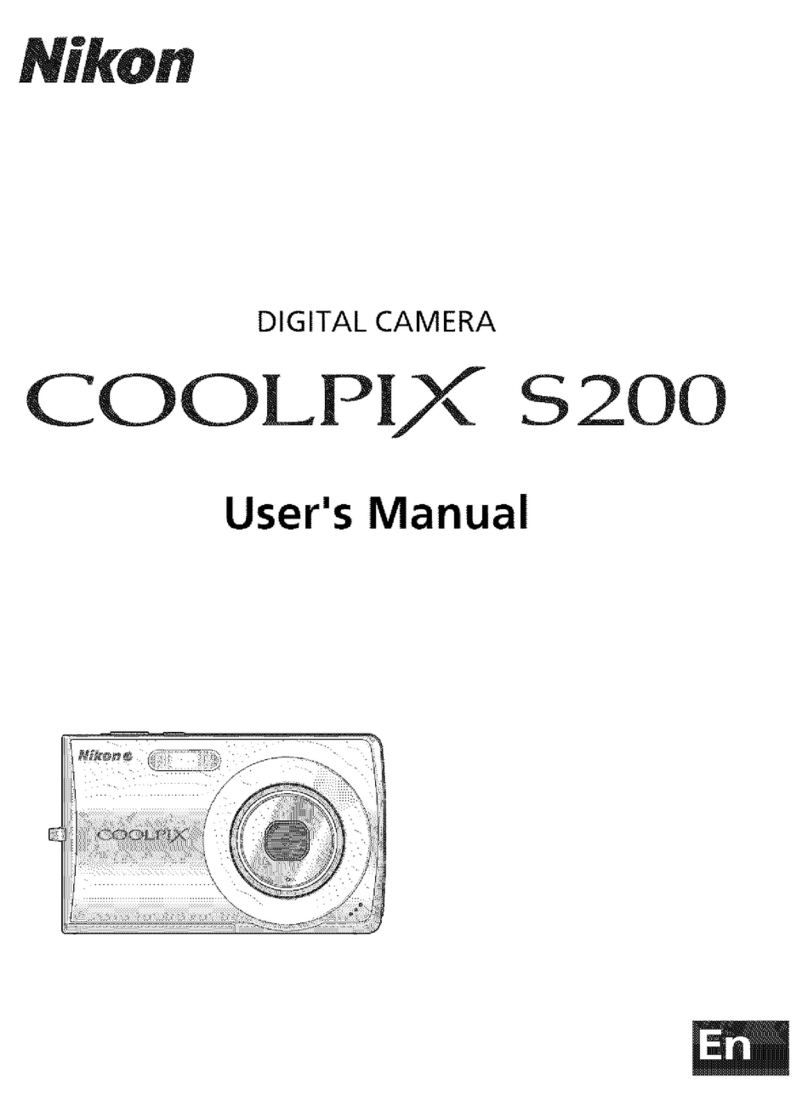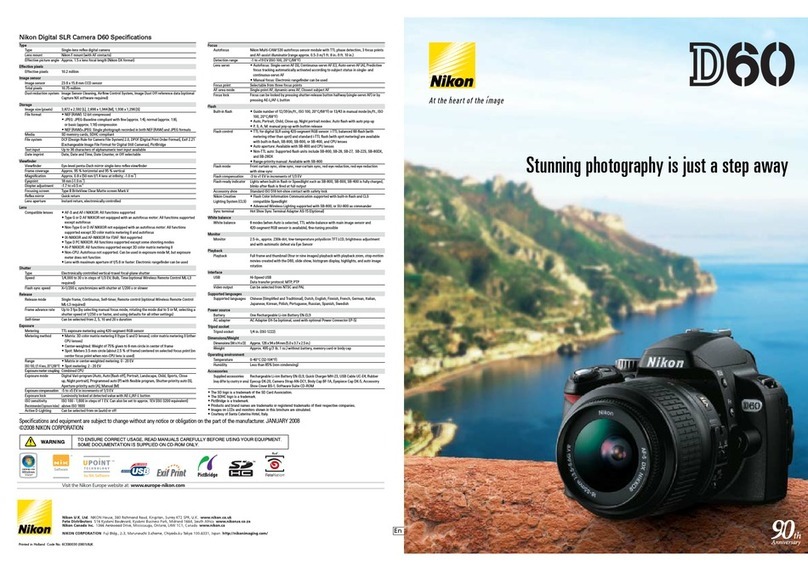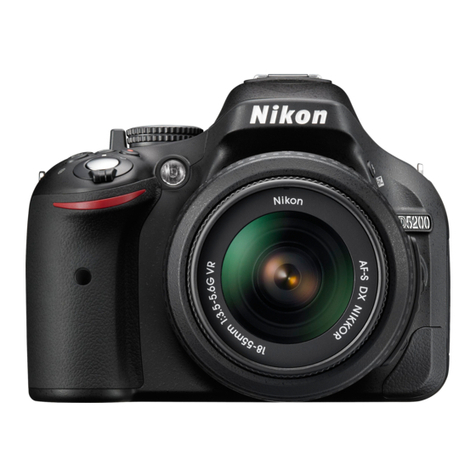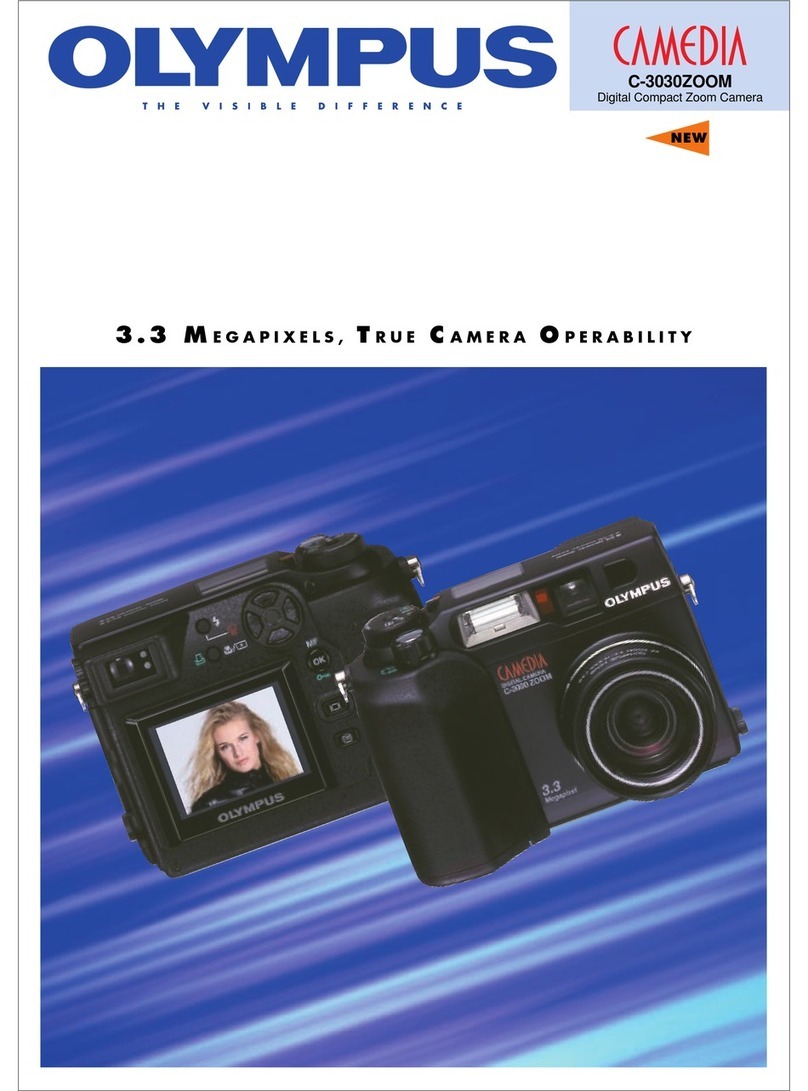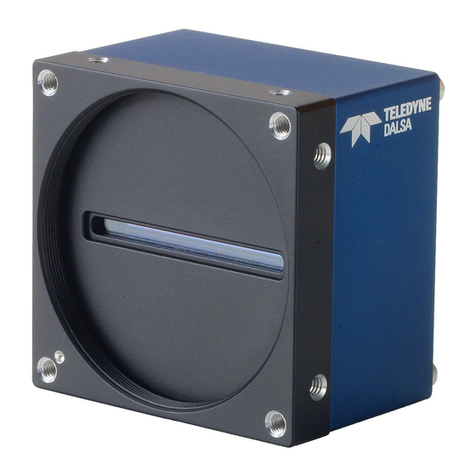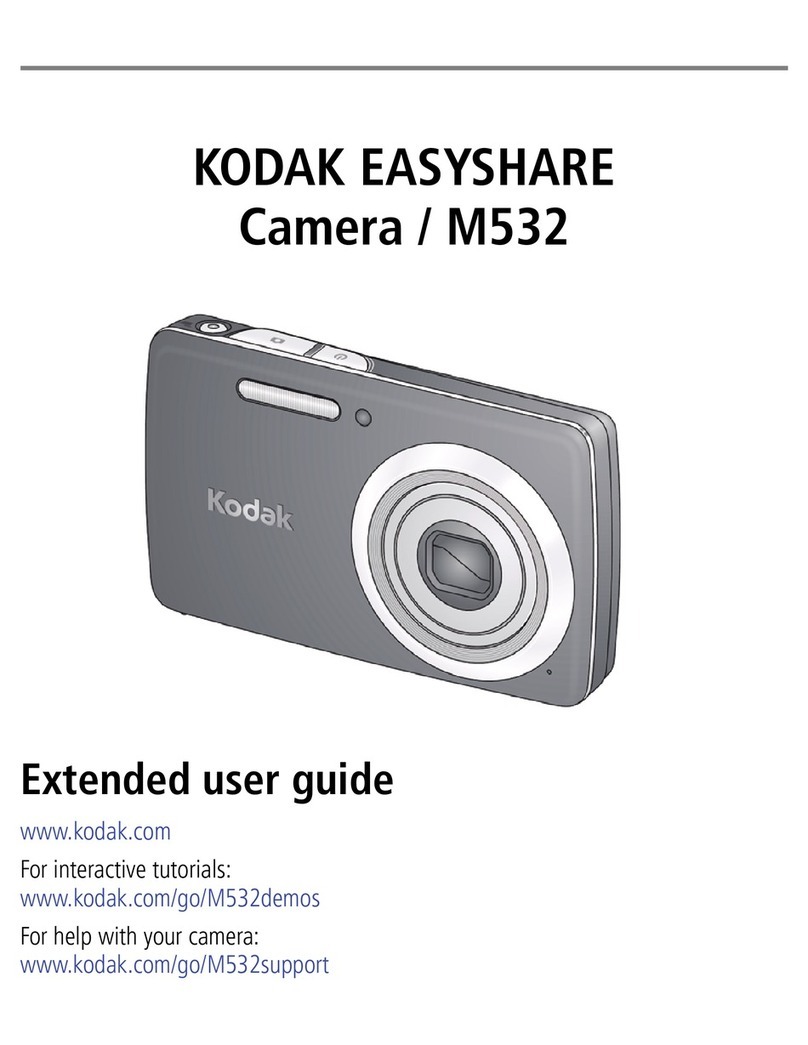www.nikondigital.com
1300 Walt Whitman Road, Melville, N.Y. 11747-3064, USA.
Lens-interchangeable digital SLR camera
4.1 million
JFET image sensor LBCAST, 23.3 x 15.5mm size, 4.26 million total pixels
[L] 2,464 x 1,632-pixel / [M] 1,840 x 1,224-pixel
ISO equivalency 200 to 1600 (Hi-1 and Hi-2 available)
NEF (12-bit uncompressed or compressed RAW),
Exif 2.21, DCF 2.0 and DPOF compliant
(uncompressed TIFF-RGB or compressed JPEG)
CompactFlash™(CF) Card (Type I/ II ) and Microdrive™
1) Single frame shooting [S] mode: advances one frame for each shutter release
2) Continuous high shooting [CH] mode: 8 frames per second (fps)
[up to 50 (JPEG)/40 (TIFF)/40 (RAW:NEF) consecutive shots]
3) Continuous low shooting [CL] mode: 1 to 7 frames per second (fps)
(selectable from menus)
4) Self-timer mode: time duration can be set
5) Mirror up mode: first press: mirror up, second press: release
1) Auto (hybrid with 1,005-pixel RGB CCD, LBCAST image sensor and
external Ambient Light Sensor)
2) Manual (6 steps with fine tuning)
3) Preset (5 settings)
4) Color temperature setting in Kelvin (select from 31 steps)
5) White Balance Bracketing (2 to 9 frames adjustable in 10, 20, 30 MIRED steps)
2.5-in., 232,000-dot, low temp. polysilicon TFT LCD with white LED backlighting;
Backlight/brightness adjustment available
1) Full frame, 2) Thumbnail (4/ 9 segments), 3) Zoom, 4) Slideshow,
5) RGB Histogram indication, Shooting data and Highlight point display
1) Card format, 2) All frames delete, 3) Selected frames delete
NTSC or PAL (switchable in menu)
USB 2.0 (Hi-Speed) (Mini-B connector)
FTP file transfer and PTP/IP camera control/file transfer is available with optional
WT-2/2A(IEEE 802.11b/g) Wireless Transmitter; FTP file transfer compatibility
with WT-1/1A (IEEE 802.11b)
CF Card Slot Type II: supports firmware updates via CF cards
Record mode: Automatic or manual recording at shooting or playback
Max. recording time: 60 seconds
Playback mode: Built-in speaker or Audio Video Cable
File format: Mono WAV file
Up to 36 characters of alphanumeric text input is available with LCD monitor and
multi-selector; stored in Exif header
1) AF Nikkor (including AF-S, DX, VR and D-/G-type): All functions possible
2) D-type Manual-Focus Nikkor: All functions except autofocus and some
exposure modes available
3) AF Nikkor other than D-/G-type: All functions except 3D-Color Matrix Metering II
and 3D Multi-Sensor Balanced Fill-Flash possible
4) AI-P Nikkor: All functions except 3D-Color Matrix Metering II ,
3D Multi-Sensor Balanced Fill-Flash and AF possible
5) Non-CPU AI Nikkor: Usable in [A] or [M] mode with Matrix Metering,
Center-Weighted and Spot Metering available
Indication of aperture No., after user inputs the aperture f/No. and focal length
f=mm by multi-selector operation
Electronic rangefinder usable with maximum aperture of f/5.6 or faster
Approx. 1.5x focal length in 35mm [135] format equivalent
Optical-type fixed eye-level pentaprism; Built-in diopter adjustment (-3 to +1m-1),
Eyepiece shutter provided
19.9mm (at -1.0m-1)
BriteView Clear Matte Screen III Type-B; interchangeable with optional
Type-E with grid
Approx. 100%
Approx. 0.86x with 50mm f/1.4 lens set to infinity and -1.0m-1
Automatic, instant-return type
Instant-return type, with Depth-of-field Preview Button
TTL phase detection, Nikon Multi-CAM 2000 autofocus module;
Detection range: EV -1 to +19 (Right edge/Left edge AF range: EV 0 to +19)
[at normal temperature (68°F/20°C), ISO 100 equivalent]
1) Single Servo AF [S], 2) Continuous Servo AF [C], 3) Manual focus [M]
Focus Tracking automatically activated by subject's status in [S] or [C] AF
Selectable from 11 focus areas
1) Single Area AF, 2) Dynamic AF with Focus Tracking and Lock-on™,
3) Closest Subject Priority Dynamic AF, 4) Group Dynamic AF
Focus is locked by pressing AE/AF Lock button or lightly pressing shutter release
button in [S] AF
Typ e of Camera
Effective Pixels
Image Sensor
Recording Pixels
Sensitivity
Storage System
Storage Media
Shooting Modes
White Balance
LCD Monitor
Playback Function
Delete Function
Video Output
Interface
Voice Memo
Text In put
Usable Lenses
Picture Angle
Viewfinder
Eyepoint
Focusing Screen
Viewfinder Frame
Coverage
Viewfinder
Magnification
Reflex Mirror
Lens Aperture
Autofocus
Lens Servo
Focus Area
AF Area Modes
Focus Lock
Nikon Digital SLR Camera D2HsSpecifications
TTL full-aperture exposure metering system;
1) D-/G-type Nikkor lenses support 3D-Color Matrix Metering II using the
1,005-pixel RGB Sensor while other AF Nikkor lenses with built-in CPUs
support Matrix Metering (Non-CPU lenses require manual input of lens data)
2) Center-Weighted Metering (75% of the meter’s sensitivity concentrated on the
8mm dia. circle) given to 6, 10 or 13mm dia. circle in center of frame, or weighting
based on average of entire frame
3) Spot Metering (3mm dia. circle, approx. 2% of entire frame); metering position
can be linked to the focus area when using Nikkor lenses with built-in CPU
1) 3D-Color Matrix Metering II: EV 0 to 20
2) Center-Weighted Metering: EV 0 to 20
3) Spot Metering: EV 2 to 20 [at normal temperature (68°F/20°C),
ISO 100 equivalent, f/1.4 lens]
CPU and AI (Automatic maximum aperture Indexing)
1) [P] Programmed Auto (Flexible program possible)
2) [S] Shutter-Priority Auto
3) [A] Aperture-Priority Auto
4) [M] Manual
Exposure compensated in ±5.0 EV range in 1/3, 1/2 or 1 EV steps
Detected exposure value locked by pressing AE-L/AF-L button
Number of shots: 2 to 9 frames
Compensation steps:1/3, 1/2, 2/3, or 1 EV steps
Electromagnetically controlled vertical-travel focal-plane shutter,
30 to 1/8,000 second and bulb
X-contact only: flash synchronization up to 1/250 second
1) New Creative Lighting System: i-TTL Balanced Fill-Flash controlled by
TTL Sensor with Nikon Speedlight SB-800/600: Advanced
Wireless Lighting, FV (Flash Value) Lock, Flash Color Information
Communication for Auto White Balance, Auto FP High-Speed Flash
Sync, Modeling Flash
2) D-TTL Balanced Fill-Flash: When used with the Speedlight SB-80DX/50DX
and in accordance with the mounted lens, five-segment TTL Multi Sensor control
makes available 3D Multi-Sensor Balanced Fill-Flash, Multi-Sensor Balanced
Fill-Flash, and Standard D-TTL Balanced Fill-Flash
3) AA (Auto Aperture-type) Flash available when used with SB-800/80DX
and lens with built-in CPU
4) Non-TTL Auto Flash (A-type Flash) with a Speedlight such as SB-800/30/27/22s etc.
5) Range-priority manual available with SB-800
1) Front-Curtain Sync (normal sync), 2) Red-Eye Reduction,
3) Red-Eye Reduction with Slow Sync, 4) Slow Sync, 5) Rear-Curtain Sync
Lights up when flash fully charged with Speedlight SB-800/600/80DX/50DX/
30/27/22s; blinks for full output warning
ISO 518 standard-type hot shoe contact; Safety lock mechanism provided
ISO 519 standard terminal, lock screw provided
Electronically controlled; Timer duration: 2, 5, 10, and 20 seconds
Stop-down lens aperture by pressing Depth-of-field Preview Button
Via 10-pin remote terminal
NMEA 0183 (ver. 2.01) interface standard supported with 9-pin D-sub cable (optional)
and GPSCable MC-35 (optional)
English, French, German, Spanish, Italian, Dutch, Swedish, Simplified Chinese,
Korean, Japanese (selectable in menu)
Rechargeable Li-ion Battery EN-EL4 (11.1V DC), Quick Charger MH-21,
AC Adaptor EH-6 (optional)
The LCD monitor on the camera back displays the following information about the
EN-EL4 battery: 1) Remaining charge (%); 2) No. of shots taken since last charge; 3)
Calibration status (Recommended/Not required); 4) Battery life (5 stages)
1/4 in. (ISO1222)
Approx. 6.2 x 5.9 x 3.4 in.(157.5 x 149.5 x 85.5mm)
Approx. 2.4 lbs (1,070g)
Rechargeable Li-ion Battery EN-EL4, Quick Charger MH-21, Body Cap,
Camera Strap AN-D2Hs, Audio Video Cable EG-D2, USB Cable UC-E4,
LCD Monitor Cover BM-3, Battery Chamber Cover BL-1, PictureProject
software CD-ROM
Wireless Transmitter WT-2/2A/1/1A, Extended Range Antenna WA-E1,
AC Adaptor EH-6, Type-E Focusing Screen, Antifog Finder Eyepiece DK-17A,
Eyepiece Correction Lens DK-17C series, Speedlight SB-800/SB-600,
Nikon Capture 4 software, CompactFlash™card
*Supplied accessories may differ in each country or area.
Exposure Metering
System
Exposure Metering
Range
Exposure Meter
Coupling
Exposure Modes
Exposure
Compensation
Auto Exposure Lock
Auto Exposure
Bracketing
Shutter
Sync Contact
Flash Control
Flash Sync Modes
Ready-light
Accessory Shoe
Sync Terminal
Self-timer
Depth-of-field
Preview Button
Remote Control
GPS
Supported
Languages
Power Requirements
Battery Monitoring
System
Tripod Socket
Dimensions
(Wx HxD)
Weight
(without battery)
Supplied
Accessories*
Optional
Accessories
http://nikonimaging.com/global/activity/npci/
Printed in Japan Code No. 6CE41585 (0502A) Ad
WARNING TO ENSURE CORRECT USAGE, READ MANUALS CAREFULLY BEFORE USING
YOUR EQUIPMENT. SOME DOCUMENTATION IS SUPPLIED ON CD-ROM ONLY.
Specifications and equipment are subject to change without any notice or obligation on the part of the
manufacturer. February 2005 c 2005 NIKON INC.
CompactFlash™is a trademark of SanDisk Corporation. Products and brand names are trademarks or registered trademarks of their respective companies.
